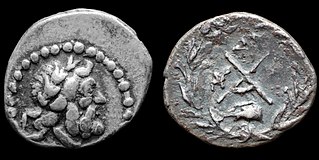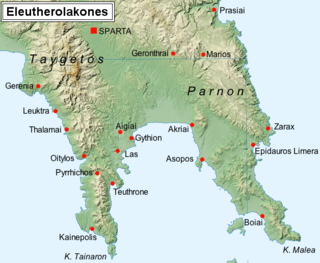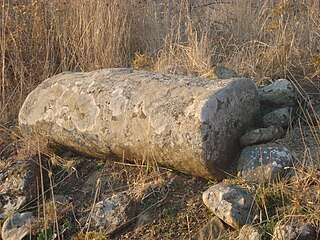Related Research Articles
Mesatis was a town of ancient Achaea, in the neighbourhood of Patrae. It is said to have been founded by the Ionians, when they occupied the country. After their expulsion,, the Achaean hero Patreus withdrew the inhabitants from Antheia and Mesatis to Aroë, which he enlarged and called Patrae after himself. The city's acropolis probably continued to be called Aroë, which was often synonymous with Patrae. In the war between the Achaeans and the Romans, Patrae suffered so severely that most residents left for the surrounding villages of Mesatis, Antheia, Bolina, Argyra, and Arba.
Aegium or Aigion, or Aegeium or Aigeion (Αἴγειον), was a town and polis (city-state) of ancient Achaea, and one of the twelve Achaean cities. It was situated upon the coast west of the river Selinus, 30 stadia from Rhypae, and 40 stadia from Helice.

Amyclae or Amyklai was a city of ancient Laconia, situated on the right or western bank of the Eurotas, 20 stadia south of Sparta, in a district remarkable for the abundance of its trees and its fertility. Amyclae was one of the most celebrated cities of Peloponnesus in the heroic age. It is said to have been founded by the Lacedaemonian king Amyclas, the father of Hyacinthus, and to have been the abode of Tyndarus, and of Castor and Pollux, who are hence called Amyclaei Fratres. Amyclae is mentioned by Homer, and it continued to maintain its independence as an Achaean town long after the conquest of Peloponnesus by the Dorians.

Dyme, or Dymae, was a town and polis (city-state) of ancient Achaea, and the most westerly of the 12 Achaean cities, from which circumstance it is said to have derived its name. The location of Dyme is near the modern Kato Achaia.
Cleonae or Kleonai was a city in ancient Peloponnesus, described by writers of the Roman period as a city of Argolis, but never included in the Argeia or territory of Argos, in the flourishing period of Greek history. Cleonae was situated on the road from Argos to Corinth, at the distance of 120 stadia from the former city, and 80 stadia from the latter. There was a narrow pass through the mountains, called Tretus, leading from Argos to Cleonae. Cleonae stood in a small plain upon a river flowing into the Corinthian Gulf a little westward of Lechaeum. In its territory was Mount Apesas, now Mount Phoukas, connected with the Acrocorinthus by a rugged range of hills. Both Strabo and Pausanias describe Cleonae as a small place; and the former writer, who saw it from the Acrocorinthus, says that it is situated upon a hill surrounded on all sides by buildings, and well walled, so as to deserve the epithet given to it by Homer in the Catalogue of Ships in the Iliad – ἐϋκτιμένας Κλεωνάς. Statius also speaks of "ingenti turritae mole Cleonae."
Helos, also Hele (Ἕλη), was a town of ancient Laconia, situated east of the mouth of the Eurotas, close to the sea, in a plain which, though marshy near the coast, is described by Polybius as the most fertile part of Laconia. In the earliest times it appears to have been the chief town on the coast, as Amyclae was in the interior; for these two places are mentioned together by Homer in the Catalogue of Ships in the Iliad. Helos is said to have been founded by Heleius, the youngest son of Perseus. On its conquest by the Dorians its inhabitants were reduced to slavery; and, according to a common opinion in antiquity, their name became the general designation of the Spartan bondsmen, helots, but the name of these slaves (εἵλωτες) probably signified captives, and was derived from the root of ἑλεῖν. In the time of Strabo Helos was only a village; and when it was visited by Pausanias, it was in ruins. Helos is also mentioned by Thucydides, Xenophon, and Stephanus of Byzantium.
Cleitor or Kleitor, also known as Clitorium, was a town in ancient Arcadia.
Methydrium or Methydrion was a town in central ancient Arcadia, situated 170 stadia north of Megalopolis. It obtained its name, like the places called Interamna, from being situated upon a lofty height between the two rivers Maloetas and Mylaon. According to Greek mythology, it was founded by Orchomenus; but its inhabitants were removed to Megalopolis, upon the establishment of that city (371 BCE). It never recovered its former population, and is mentioned by Strabo among the places of Arcadia which had almost entirely disappeared. It continued, however, to exist as a village in the time of Pausanias, who saw there a temple of Poseidon Hippius upon the river Mylaon. He also mentions, above the river Maloetas, a mountain called Thaumasium, in which was a cave where Rhea took refuge when pregnant with Zeus. At the distance of 30 stadia from Methydrium was a fountain named Nymphasia. Methydrium is also mentioned by Thucydides, Xenophon,, Polybius, Pliny the Elder, and Stephanus of Byzantium.
Orneae or Orneai was a town in ancient Argolis, mentioned by Homer in the Catalogue of Ships in the Iliad, which is said to have derived its name from Orneus, the son of Erechtheus. Orneae retained its ancient Cynurian inhabitants, when Argos was conquered by the Dorians. According to Pausanias, it continued independent of Argos for a long time; but it was finally conquered by the Argives, who removed the Orneatae to their own city. Thucydides mentions the Orneatae and Cleonaei as allies (σύμμαχοι) of the Argives in 418 BCE; and the same historian relates that Orneae was destroyed by the Argives in 416 BCE. It might therefore be inferred that the destruction of Orneae by the Argives in 416 BCE is the event referred to by Pausanias. But Herodotus states that Orneae had been conquered by Argos long before; that its inhabitants were reduced to the condition of Perioeci; and that all the Perioeci in the Argeia were called Orneatae from this place. But the Orneatae mentioned by Thucydides could not have been Perioeci, since they are called allies. "The Cynurians," says Herodotus, "have become Doricized by the Argives and by time, being Orneatae and Perioeci." These words would seem clearly to mean that, while the other Cynurians became Perioeci, the Orneatae continued independent, an interpretation which is in accordance with the account of Thucydides.
Prasiae or Prasiai, or Prasia (Πρασία), also known as Brasiae or Brasiai (Βρασιαί), was a town on the eastern coast of ancient Laconia, described by Pausanias as the farthest of the Eleuthero-Laconian places on this part of the coast, and as distant 200 stadia by sea from Cyphanta. The Periplus of Pseudo-Scylax speaks of it as a city and a harbour.
Pellene was a city and polis (city-state) of ancient Achaea, the most easterly of the twelve Achaean cities. Its territory bordered upon that of Sicyon on the east and upon that of Aegeira on the west. Pellene was situated 60 stadia from the sea, upon a strongly fortified hill, the summit of which rose into an inaccessible peak, dividing the city into two parts. Its port was at Aristonautae.

Olenus or Olenum was a polis (city-state) in ancient Achaea, Greece. It was an original member of the Achaean League, one of the 12 Achaean cities, situated on the coast, and on the left bank of the river Peirus, 40 stadia from Dyme, and 80 stadia from Patrae. On the revival of the Achaean League in 280 BCE, it appears that Olenus was still in existence, as Strabo says that it did not join the league; but the inhabitants subsequently abandoned the town, and retired to the neighbouring villages of Peirae (Πειραί), and Euryteiae (Εὐρυτειαί), and to Dyme. In the time of Polybius, however, Olenus was no longer inhabited; and in the time of Pausanias it was in ruins, and its territory belonged to Dyme.
Pharae was an ancient town of Messenia, situated upon a hill rising from the left bank of the river Nedon, and at a distance of a mile (1.5 km) from the Messenian Gulf. Strabo describes it as situated 5 stadia from the sea, and Pausanias 6. William Smith states that it is probable that the earth deposited at the mouth of the river Nedon has, in the course of centuries, encroached upon the sea. Pausanias distinguishes this city from the Achaean city of Pharae (Φαραὶ), 150 stadia from Patrae and 70 stadia from the coast. Pherae occupied the site of Kalamata, the modern capital of Messenia; and in antiquity also it seems to have been the chief town in the southern Messenian plain.
Oechalia or Oichalia was a town in ancient Messenia, in the plain of Stenyclerus. It was in ruins in the time of Epaminondas, and its position was a matter of dispute in later times. Strabo identified it with Andania, the ancient residence of the Messenian kings, and Pausanias with Carnasium, which was only 8 stadia distant from Andania, and upon the river Charadrus. Carnasium, in the time of Pausanias, was the name given to a grove of cypresses, in which were statues of Apollo Carneius, of Hermes Criophorus, and of Persephone. It was here that the mystic rites of the great goddesses were celebrated, and that the urn was preserved containing the bones of Eurytus, the son of Melaneus.
Antheia or Anthea was a town in ancient Achaea, which was said to have been depopulated by the mythical Patreus to populate Patrae. During the war between the Achaeans and the Romans, Patrae suffered so severely, that the greater part of the inhabitants abandoned the city and took up abodes in the surrounding villages, including Antheia. Here, Demeter Poteriophoros was worshiped.
Cyllene or Kyllene was a seaport town of ancient Elis, distant 120 stadia from the city of Elis. Cyllene was an ancient place. It is mentioned by Homer as one of the towns of the Epeians; and if we are to believe Dionysius Periegetes, it was the port from which the Pelasgians sailed to Italy. Pausanias, moreover, mentions it as visited at an early period by the merchants of Aegina, and as the port from which the exiled Messenians after the conclusion of the Second Messenian War, sailed away to found a colony in Italy or Sicily.

Thalamae or Thalamai was a town of ancient Laconia, which at various times belonged to Messenia.

Tritaea or Tritaia was a polis (city-state) of Achaea, and the most inland of the 12 Achaean cities, was distant 120 stadia from Pharae. According Pausanias, Tritaea's foundation was said to be due to either: Celbidas, who came from Cumae; or Melanippus, a son of Ares and Triteia, herself a daughter of Triton and priestess of Athena, and that Melanippus named the town after his mother.
Argyra was a town or village in ancient Achaea, in the neighbourhood of Patrae. It was located near the river Selemnus, the spring Argyra and the town of Bolina. Pausanias says it was on the road from Patrae to Aegium, following the Caradrus river. Pausanias relates a local legend that Argyra was a sea-nymph, who fell in love with a shepherd named Selemnus and used to come up out of the sea to visit him, sleeping by his side, but when Selemnus lost its beauty, the nymph stopped visiting him and Selemnus died of a broken heart. Then, Aphrodite transformed Selemnus into a river. In the war between the Achaeans and the Romans Patrae suffered so severely, that the greater part of the inhabitants abandoned the city and took up their abodes in the surrounding villages of Mesatis, Antheia, Bolina, Argyra, and Arba. A long time later, the Emperor Augustus forced the inhabitants of these places to abandon them to repopulate the city of Patrae. In the time of Pausanias the town was in ruins.
Belemina, or Belmina (Βέλμινα), or Belbina (Βελβίνα), or Blenina (Βλένινα), was a town of ancient Laconia and ancient Arcadia, at the northwest frontier of the former, the territory of which was called Belminatis (Βελμινᾶτις). It was originally an Arcadian town, but was conquered by the Lacedaemonians at an early period, and annexed to their territory; although Pausanias does not believe this statement. After the Battle of Leuctra, Belemina was restored to Arcadia, reckoned to be part of Aegytis; most of its inhabitants were removed to the newly founded city of Megalopolis; and the place continued to be a dependency of the latter city. In the wars of the Achaean League, the Belminatis was a constant source of contention between the Spartans and Achaeans. Under Machanidas or Nabis, the tyrants of Sparta, the Belminatis was again annexed to Laconia; but upon the subjugation of Sparta by Philopoemen in 188 BCE, the Belminatis was once more annexed to the territory of Megalopolis. The Belminatis is a mountainous district, in which the Eurotas takes its rise from many springs. Belemina is said by Pausanias to have been 100 stadia from Pellana.
References
- ↑ Stephanus of Byzantium. Ethnica. Vol. s.v.
- ↑ Mogens Herman Hansen & Thomas Heine Nielsen (2004). "Achaia". An inventory of archaic and classical poleis. New York: Oxford University Press. pp. 485–486. ISBN 0-19-814099-1.
- ↑ Herodotus. Histories . Vol. 1.145.
- ↑ Polybius. The Histories . Vol. 2.41.
- ↑ Pausanias (1918). "18.7". Description of Greece. Vol. 7. Translated by W. H. S. Jones; H. A. Ormerod. Cambridge, Massachusetts; London: Harvard University Press; William Heinemann – via Perseus Digital Library.
- ↑ Pausanias (1918). "6.1". Description of Greece. Vol. 7. Translated by W. H. S. Jones; H. A. Ormerod. Cambridge, Massachusetts; London: Harvard University Press; William Heinemann – via Perseus Digital Library., 7.23.4.
- 1 2 Strabo. Geographica . Vol. 8.7.5. Page numbers refer to those of Isaac Casaubon 's edition.
- ↑ Thucydides. History of the Peloponnesian War . Vol. 7.34.
- ↑ Pausanias (1918). "22.10". Description of Greece. Vol. 7. Translated by W. H. S. Jones; H. A. Ormerod. Cambridge, Massachusetts; London: Harvard University Press; William Heinemann – via Perseus Digital Library.
- ↑ Pliny. Naturalis Historia . Vol. 4.6.
- ↑ Lund University. Digital Atlas of the Roman Empire.
- ↑ Richard Talbert, ed. (2000). Barrington Atlas of the Greek and Roman World . Princeton University Press. p. 58, and directory notes accompanying. ISBN 978-0-691-03169-9.
![]() This article incorporates text from a publication now in the public domain : Smith, William, ed. (1854–1857). "Rhypes". Dictionary of Greek and Roman Geography . London: John Murray.
This article incorporates text from a publication now in the public domain : Smith, William, ed. (1854–1857). "Rhypes". Dictionary of Greek and Roman Geography . London: John Murray.